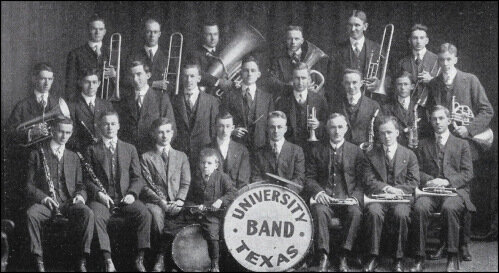1900 - There was no great band of the Southwest. Music was a makeshift affair, so Dr. Eugne P. Schoch, a Chemistry professor and a musician in concert with Dr. H.E. Baxter, a local dentist, purchased for $150 two used drums and 12 used instruments.
They then recruited 16 students who knew how to beat drums and play instruments and dressed them in white linen dusters and white caps with black bills, and that my friends represent the first Show Band of the Southwest.
1908 Varsity Band
Officially Baxter was the first band director, followed by Schoch. After five years, Schoch stepped down as director, but he continued to serve as a chaperone for the band. For the next seven years, the Longhorn Band was run by students.
1908 - Texas rooter staged an “interhalf parade” on the field. While the band played, the rooters used brooms to demonstrate “a clean sweep of Texas A&M resulting in a fight and stabbing of Texas student William Trenekmann.
By 1917 the Longhorn Band included 35 pieces.
In 1920 Regent Lutcher Stark presented the band with their first modern uniforms, of white serge with an orange stripe down the trousers' side. The tunic front was orange silk.
1920
In 1921, Mr. Burnett "Blondie" Pharr became the director of the Longhorn Band. Pharr developed the young band and led it on tour through 17 states, performing at the Chicago World's Fair, Madison Square Garden, and Washington, D.C. The process did not occur overnight, but slowly the band members lost discipline, and funding became scarce. So on game days, the band uniforms were no longer pristine, and the music sounded more like sounds played at an American Legion convention.
Colonel George E. Hurt became director of the “Show less Band of the Southwest” in 1936. Under his tenure, the Longhorn Band grew to over 200 members. Hurt brought military precision back to the band members' band and a sense of pride of belonging to the band. While Colonel Hurt did a great job with discipline, enthusiasm to join the Longhorn band dwindled during his tenure.
After Col. Hurt suffered a stroke in 1949, Moton Crockett assumed the Longhorn Band's directorship. Colonel D. Harold Byrd supplanted Lutcher Stark as the benefactor, giving away prizes to outstanding band members. He donated Big Bertha, the “world’s largest drum,” in 1954 and purchased new uniforms for band members when necessary.
Vincent R. DiNino 1955- 1975
1958 band tribute to Santa Rita
DiNino is one of the very few who have been named honorary “T” men or football lettermen.
Vincent R. DiNino replaced Moton Crockett after he retired, and Dinio updated the music and uniforms of the Longhorn Band. New music included Jazz, popular songs, and show tunes. DiNino had the right formula for entertainment, and the band grew from 40 to 400 before he pared it down to 300.
DiNino's time as director saw the introduction of many other traditions and characteristics of the band, such as the western-style uniforms, Big Flags Brigade, the Longhorn Alumni Band, and cowbells. DiNino oversaw the introduction of women into the band in a position besides majorette in 1956 and the integration of the band in 1962. The adoption of the moniker "Showband of the Southwest" also occurred during this time.
1963
In 1970 Dinino introduce the Wabash Cannonball, a Royal favorite. It is still a crowd favorite at half-time.
Under Mr. DiNino, the Longhorn Band performed in the inaugural parades of Presidents John F. Kennedy and Lyndon B. Johnson.
1975–2001
Tom C. Rhodes served as director of the band from 1975 to 1980. Glenn A. Richter, an alumnus of the University of Texas, returned to his alma mater as director of the Longhorn Band from 1980 to 1995. Paula Crider became director in 1995 and remained until 1999. Kevin Sedatole served as director for the short span from 1999 to 2001.
1977
2001–2010
Dr. Robert Carnochan assumed the directorship of the Longhorn Band in 2001. He served as director until 2015, leaving the Longhorn Band for a position as the Director of Bands at the University of Miami.
Dr. Scott Hanna became the 12th director of the Longhorn Band in 2015. Dr. Hanna had served as the band's associate director for sixteen years before he was appointed director.
2012
2022 Big Bertha II
Big Bertha II, Largest Bass Drum in the World, to Make Debut at Texas-Iowa State Game
Left: Big Bertha, 2021. Photo by Ralph Arveson. Right: Big Bertha II, shown at A&F Drum Co., October 2022. Photo by Steven Gunter.
AUSTIN, Texas — Big Bertha II, a new bass drum custom-built for the Longhorn Band at The University of Texas at Austin, will debut at the Oct. 15 football game between Texas and Iowa State University. After 100 years of service, the original Big Bertha will make her final appearance alongside Big Bertha II before entering the Frank Denius Family University of Texas Athletics Hall of Fame. Both drums will be on the field for the first and only time during the halftime show, which will feature the Longhorn Band alongside the Longhorn Alumni Band.
Then-Longhorn Band Director Moton Crockett presenting Big Bertha to incoming Director Vincent DiNino.
“We’re not saying goodbye to Big Bertha, but we felt like her centennial was the perfect time to honor her by moving her to the Hall of Fame,” said Longhorn Band Director Cliff Croomes. “We’re excited to introduce Big Bertha II to our fans and to have a new drum that this generation and future generations will be able to enjoy.”
A fan favorite, Big Bertha has a storied history with the Longhorn Band, and she plays a prominent ceremonial role in home football games. Big Bertha leads the Longhorn Band onto the field for football games, and she’s played during the national anthem and “The Eyes of Texas,” the university’s alma mater, and after the team scores. Big Bertha was named after the World War I-era German Big Bertha howitzer because of her sound and volume.
The original Big Bertha was commissioned by the University of Chicago in 1922, and then-Longhorn Band Director Moton Crockett purchased the drum for the Longhorn Band in 1954. Crockett refurbished the drum and presented it to incoming Longhorn Band Director Vincent DiNino in 1955.
In her more than 60 years at The University of Texas at Austin, Big Bertha has made countless appearances at football games. She traveled to the Rose Bowl, and in 2015, she was shipped overseas to London as part of the Longhorn Alumni Band appearance in the London New Year’s Day Parade. Big Bertha has appeared on “Jimmy Kimmel Live!” and was the subject of the A&E show “Shipping Wars.”
Big Bertha II was built in Austin this past year by local business A&F Drum Co. The new drum will measure just over 9.5 feet in diameter and will be 55 inches wide. (By contrast, the original Big Bertha is 8 feet in diameter and 41 inches wide.) The drum was manufactured with a proprietary material with aluminum, and it will be wired with an internal mic system that will allow it to wirelessly connect to the stadium sound system. Big Bertha II will be the largest bass drum in the world and will play the lowest note ever on a bass drum.
Credit: Steven Gunter, Pearlsnap Photography.
“Bertha is loud. Big Bertha II will be cacophonous,” Croomes said. “I’m honored to be a part of this transition as we honor our history and plan for our future.”
The purchase of Big Bertha II was made possible by the generosity of donors to the Big Bertha Centennial Campaign, including Dennis and Louise Griffith, Brien, Anne Smith, and Lisa Hannusch.
Copy link email Share Link Twitter Share Link Facebook Share Link LinkedIn Share Link
Tags: Arts, Butler School of Music, College of Fine Arts
Link to the 2023 Big 12 OSU and Texas game is below.
2023 Texas vs. Oklahoma State































